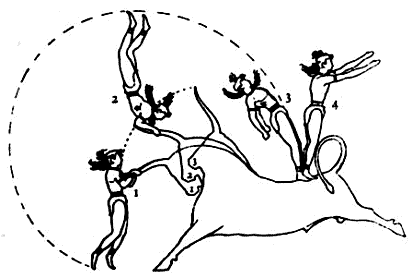|
Bull-Leaping Fresco
The bull-leaping fresco is the most completely restored of several stucco panels originally sited on the upper-story portion of the east wall of the palace at Knossos in Crete. It shows a bull-leaping scene. Although they were frescos, they were painted on stucco relief scenes. They were difficult to produce. The artist had to manage not only the altitude of the panel but also the simultaneous molding and painting of fresh stucco. The panels, therefore, do not represent the formative stages of the technique. In Minoan chronology, their polychrome hues – white, pale red, dark red, blue, black – exclude them from the Early Minoan (EM) and early Middle Minoan (MM) Periods. They are, in other words, instances of the "mature art" created no earlier than MM III. The flakes of the destroyed panels fell to the ground from the upper story during the destruction of the palace, probably by earthquake, in Late Minoan (LM) II. By that time the east stairwell, near which they fell, was disu ... [...More Info...] [...Related Items...] OR: [Wikipedia] [Google] [Baidu] |
Fresco
Fresco (plural ''frescos'' or ''frescoes'') is a technique of mural painting executed upon freshly laid ("wet") lime plaster. Water is used as the vehicle for the dry-powder pigment to merge with the plaster, and with the setting of the plaster, the painting becomes an integral part of the wall. The word ''fresco'' ( it, affresco) is derived from the Italian adjective ''fresco'' meaning "fresh", and may thus be contrasted with fresco-secco or secco mural painting techniques, which are applied to dried plaster, to supplement painting in fresco. The fresco technique has been employed since antiquity and is closely associated with Italian Renaissance painting. The word ''fresco'' is commonly and inaccurately used in English to refer to any wall painting regardless of the plaster technology or binding medium. This, in part, contributes to a misconception that the most geographically and temporally common wall painting technology was the painting into wet lime plaster. Even in app ... [...More Info...] [...Related Items...] OR: [Wikipedia] [Google] [Baidu] |
Aurochs
The aurochs (''Bos primigenius'') ( or ) is an extinct cattle species, considered to be the wild ancestor of modern domestic cattle. With a shoulder height of up to in bulls and in cows, it was one of the largest herbivores in the Holocene; it had massive elongated and broad horns that reached in length. The aurochs was part of the Pleistocene megafauna. It probably evolved in Asia and migrated west and north during warm interglacial periods. The oldest known aurochs fossils found in India and North Africa date to the Middle Pleistocene and in Europe to the Holstein interglacial. As indicated by fossil remains in Northern Europe, it reached Denmark and southern Sweden during the Holocene. The aurochs declined during the late Holocene due to habitat loss and hunting, and became extinct when the last individual died in 1627 in Jaktorów forest in Poland. The aurochs is depicted in Paleolithic cave paintings, Neolithic petroglyphs, Ancient Egyptian reliefs and Bronze ... [...More Info...] [...Related Items...] OR: [Wikipedia] [Google] [Baidu] |
Minoan Frescos
The Minoan civilization was a Bronze Age Aegean civilization on the island of Crete and other Aegean Islands, whose earliest beginnings were from 3500BC, with the complex urban civilization beginning around 2000BC, and then declining from 1450BC until it ended around 1100BC, during the early Greek Dark Ages, part of a wider bronze age collapse around the Mediterranean. It represents the first advanced civilization in Europe, leaving behind a number of massive building complexes, sophisticated art, and writing systems. Its economy benefited from a network of trade around much of the Mediterranean. The civilization was rediscovered at the beginning of the 20th century through the work of British archaeologist Sir Arthur Evans. The name "Minoan" derives from the mythical King Minos and was coined by Evans, who identified the site at Knossos with the labyrinth of the Minotaur. The Minoan civilization has been described as the earliest of its kind in Europe, and historian Will Dur ... [...More Info...] [...Related Items...] OR: [Wikipedia] [Google] [Baidu] |

.jpg)
.jpg)